Stonehenge Photos: Investigating How the Mysterious Structure Was Built
Mysterious megaliths
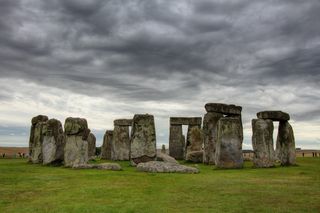
One of the most enduring mysteries of Stonehenge is how the Neolithic people who built the massive structure about 5,000 years ago were able to move the enormous stone blocks into place on the Salisbury Plain of southwest England.
The largest "sarsen" sandstone blocks that make up the main ring of Stonehenge weigh up to 32 tons, and were probably transported from an ancient quarry located about 20 miles (32 kilometers) to the north.
But the many smaller dolerite "bluestones," which weigh up to 2 tons and are used to mark ceremonial circles and points around the sarsen stones, were transported around 150 miles (240 km) from western Wales. [Read full story about how Stonehenge was built]
Old legend

This 14th-century manuscript in the British Library shows the earliest known image of Stonehenge, and records the legend that the stone circle was first built by giants in Ireland, using magical "healing" stones carried from Africa.
According to the legend, Stonehenge was magically moved to England and rebuilt at the direction of the wizard Merlin, as a monument for British knights killed in the wars against the invading Saxons.
This image shows Merlin wearing a purple hat, standing between two giants at Stonehenge. One giant holds a sarsen stone upright while the other places a lintel stone across the top.
Hauling stones

Recently, a group of students from University College London (UCL), in the United Kingdom, staged an archaeology experiment to learn how ancient peoples may have moved the stones of Stonehenge.
The students were testing the use of a wishbone- or Y-shaped wooden sled to haul the stone block over a trackway of sawn logs, a technology known in prehistoric times and still used in some parts of the world today.
The experiment took place in London's Gordon Square, near UCL's Institute of Archaeology.
Archaeology experiment

The experiment's organizer, Barney Harris, is seen here standing at the right, in a blue shirt and jeans. Harris is studying for a doctorate degree in archaeology at UCL.
Harris told Live Science that the experiment showed it was easier to move the block than he had originally calculated. Just 10 people were needed to move the 1-ton block at a rate of 10 feet (3 meters) in five seconds, equivalent to a speed of around 1 mile per hour (1.6 km/h) of continuous hauling.
Massive stones
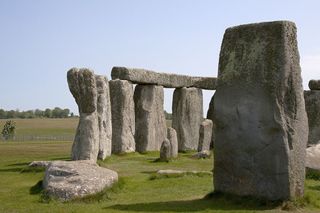
Harris thinks similar techniques on a much larger scale may have been used to haul the large sarsen stones into place at Stonehenge from about 20 miles (32 km) away. His experiment focused on techniques for moving the smaller bluestones, which can be seen in this photograph between the sarsen stones.
Based on the results of the experiment, Harris estimates a team of 20 people would have been able to transport one of the bluestones overland to Stonehenge using a wooden sled.
By land or water?
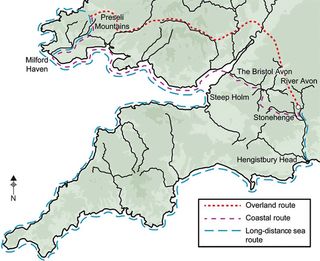
In 2014, archaeologists at UCL said they had identified the location near the western tip of Wales where most of the bluestones were quarried, about 150 miles (240 kilometers) overland from Stonehenge in Wiltshire, England.
The researchers also considered two proposed routes that the stones may have taken: by land or a "coastal route" using wooden rafts to float the stones.
Based on the latest finds, the researchers thought it more likely that the overland route was used.
Heave-ho!
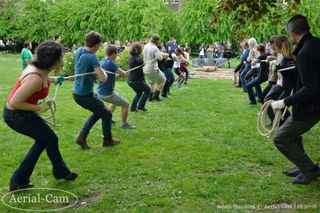
Even using a sled, at a speed of around 1 mile per hour, such a journey must have taken each hauling team many months to complete, the researchers said.
There are around 43 bluestones at Stonehenge today, but more were originally transported to the site to build the stone circle and other Neolithic ceremonial sites nearby. Many were removed in later centuries, mainly for use as building materials.
Sign up for the Live Science daily newsletter now
Get the world’s most fascinating discoveries delivered straight to your inbox.
Teamwork

Harris said he will use data from the experiment in London's Gordon Square, and future experiments, to calculate a revised figure for the amount of labor required to build Stonehenge.
An estimate by an archaeologist in 1951 suggested 30 million hours of human labor were needed to build Stonehenge. Harris said his research indicates less labor would likely have been needed to build Stonehenge, but that was only part of the effort needed to build hundreds of Neolithic ceremonial sites across England.
More than meets the eye
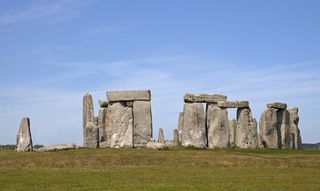
Recent archaeological studies have found that Stonehenge lies near the center of a much larger complex of Neolithic ceremonial circles, processional avenues and barrow graves. Many of the ancient monuments of wood and stone have left little trace, and were discovered by aerial geomagnetic surveys and ground-penetrating radar.
Tom Metcalfe is a freelance journalist and regular Live Science contributor who is based in London in the United Kingdom. Tom writes mainly about science, space, archaeology, the Earth and the oceans. He has also written for the BBC, NBC News, National Geographic, Scientific American, Air & Space, and many others.
